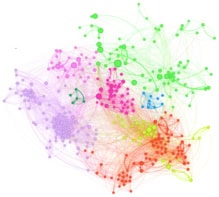If you and your best friend stop talking to each other after a massive row, you might think that would break up your entire social network. In fact, researchers studying the communication patterns of 4.6 million mobile-phone users suggest that your social circle is more likely to break into smaller clusters if you lose contact with more casual acquaintances (arXiv.org/physics/0610104).

Most technological and biological networks collapse when strong ties are removed. A gel, for example, loses its mechanical strength when enough bonds between neighbouring molecules are broken. However, Jukka-Pekka Onnela of Oxford University and the Helsinki University of Technology along with collaborators in the US and Hungary have concluded that weak ties between individuals play a much more crucial role in social networks.
The study, which used 18 weeks of call records from a European mobile phone network, assumed that two users were “tied” if they both phone each other at least once. The strength of that tie is then defined as the total duration of all calls between two users. This reveals a social network, in which a significant number of individuals are linked together (see figure “Ties that bind”).
The researchers removed ties between individuals in rank order from weakest to strongest. To their surprise, the network did not remain intact, but underwent a “percolation” phase transition splitting into a collection of unconnected islands, in which individuals were linked to only a small number of other phone users. However, if ties were removed in rank order from strongest to weakest, there was little effect on the network (see figure “Ties that bind”).
According to Onnela, weak links could be important because they tend to be “long-range” interactions that link individuals in different social groups. Conversely, strong ties tend to be “short-range”, linking individuals in the same social group. As a result, the removal of the weak links had a much greater effect on the overall structure of the network.
The results of the study could find application in epidemiology because many infectious diseases tend to spread via social networks. It could also be used in the study of how rumours and other social phenomena move through a social group.



